The Google Nexus 6P Review
by Andrei Frumusanu on December 16, 2015 8:00 AM ESTSystem & CPU Performance
The Nexus 6P comes with a Snapdragon 810 designed by Qualcomm. This is a big.LITTLE 4x A53 @ 1.55GHz + 4x A57 @ 1.95GHz SoC. As we’ve hopefully come to be very familiar with the chipset over the last couple of months, the key characteristics with which the 6P can differentiate itself from other Snapdragon 810 devices is through software optimizations. In particular the fact that the Nexus 6P comes with Android 6.0 Marshmallow should allow it to be able to showcase some improvements which we’ll dive into a bit later.
First we start by comparing performance of some of our browser-based benchmarks. These are predominantly Javascript tests which require large single-core performance out of the device’s SoCs.
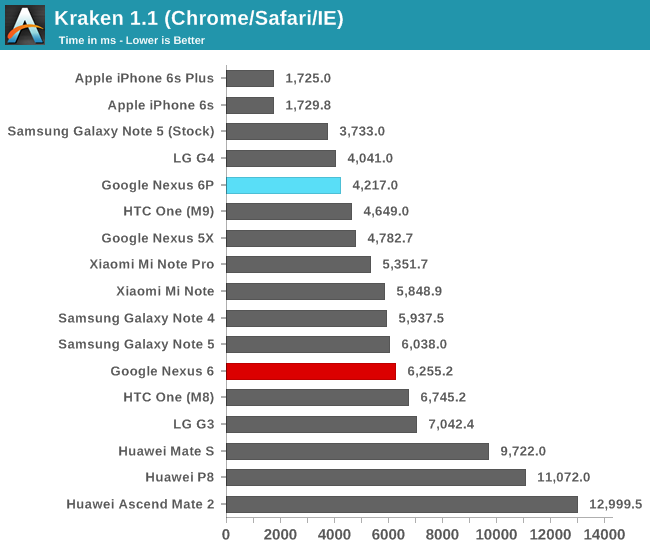
In Kraken the Nexus 6P is able to showcase a very good score that’s only beat by, oddly enough, the LG G4. As we’ve come to discover over the past year OEM browser libraries play a large role in device performance, even though we’re using the same Chrome build across different devices we see large differences in performance even within devices who employ the same SoC. It’s relatively unnerving to see this fragmentation in the ecosystem and in particular Chrome performing so differently across devices.
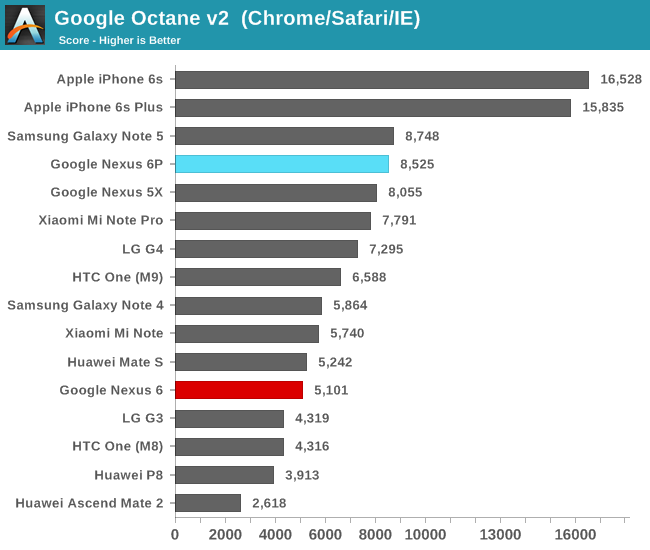
In Octane the Nexus 6P again performs very well, this time again beating our other devices such as the HTC One M9 or the Xiaomi Mi Note Pro. Among Android devices, only the Galaxy Note 5 - which on Octane is able to show equal performance as it does in its optimized stock browser - is able to beat it.
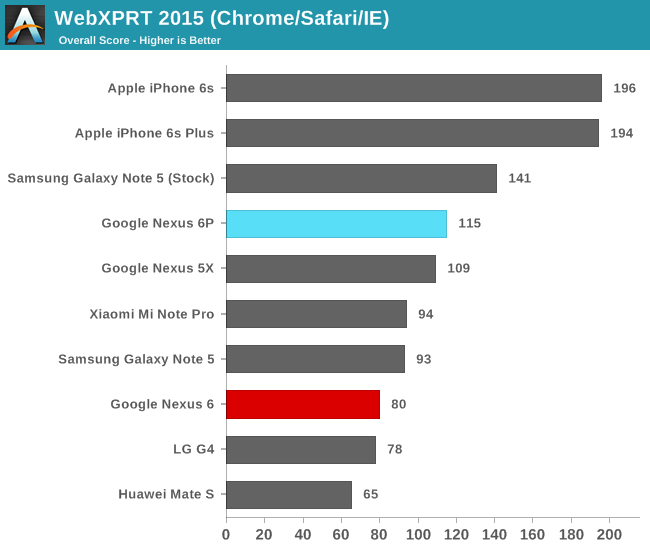
On WebXPRT again we see the 6P performs extremely well among Android devices, only being able to be beat by Samsung’s Exynos 7420 devices in the stock browser.
Continuing onto our system benchmarks, we start with Basemark OS II 2.0 from Basemark (formerly Rightware).

In the web test the Nexus 6P is yet again found at the high-end of the charts as it is able to provide good numbers. As we’ve seen in reviews such as on the Mate S it’s not necessarily raw performance that is demanded in these tests but also performance latency which plays a big role.
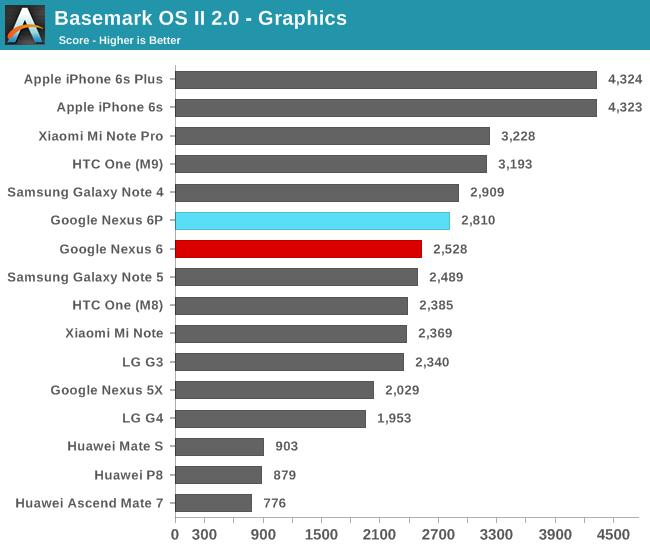
The graphics sub-test of Basemark has always been kind to the Adreno GPU so here again we see the Nexus 6P perform well, although not quite up to par with the other Snapdragon 810 devices we’ve tested in the past.
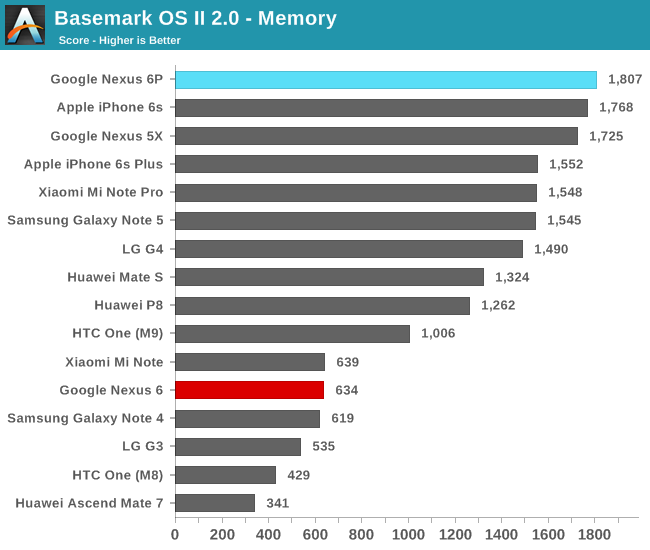
The Nexus 6P comes in a surprising first place on Basemark OS’s memory test. Again this is a mainly NAND-limited test but in contrast to our other synthetic test, performance and access patterns try to simulate more real-world applications.
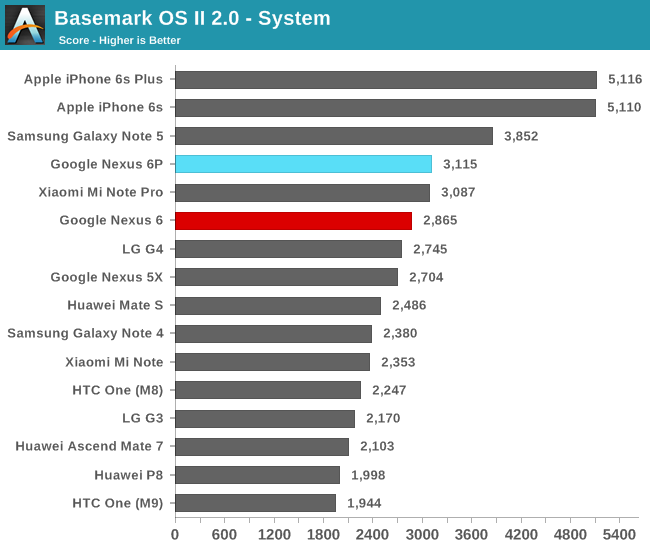
While the other tests try to test more realistic workloads, the system benchmark is all about measuring peak performance in a given set of scenarios. Here the Nexus 6P fares similarly to the Xiaomi Mi Note Pro but falls behind Exynos 7420 devices such as the Note 5.
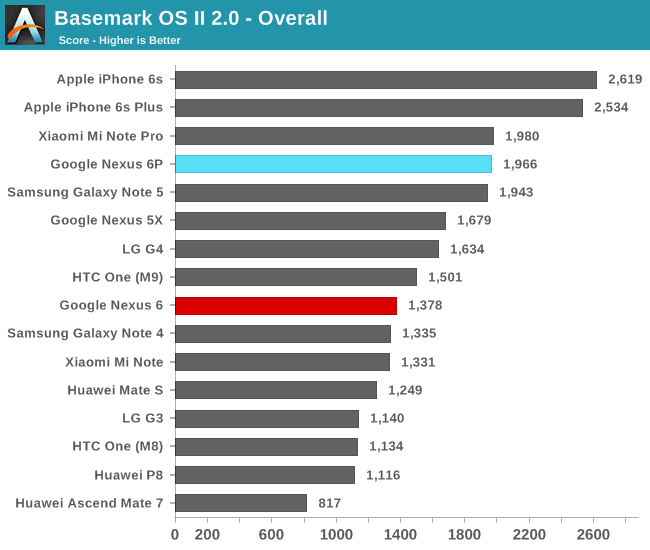
While I’m not a great fan of overall aggregate benchmark scores, we still see the Nexus 6P among the top of today’s currently available Android devices.
Moving on to PCMark from Futuremark, we’ll use a suite of tests that not only try to mimic real-world usage patterns, but actually make use of APIs that we currently find in use by many day-to-day applications.
Starting with the web browsing test we find the application use Android’s built-in WebView container which relies on OS-dependent components.
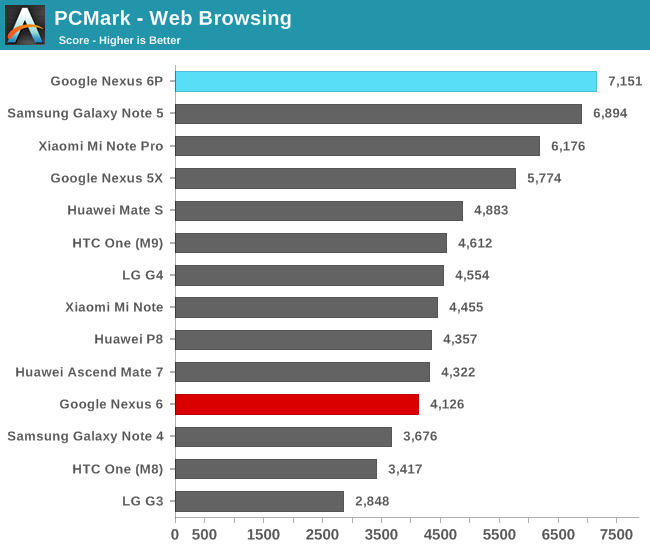
Here we see the Nexus 6P lead performance, slightly beating the Note 5. We’re also likely seeing advantages due to Android 6.0 as the Mi Note Pro, our other device with the Snapdragon 810 lags over a thousand points behind.

On the video playback score the Nexus 6P comes in towards the middle of the pack. The video test is a benchmark of both the video decoding hardware and software layers of the device, as well as the NAND speed, as fast seeking through the video is performed to test out how rapidly the device can resume playback.
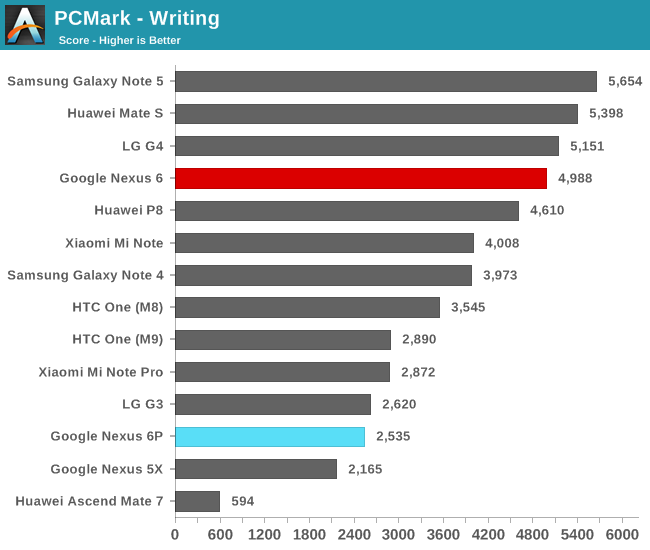
Now onto the writing test we come to one of the larger mysteries of the new Nexus 6’s performance. Both the Nexus 5X and the 6P seem to have large issues with PCMark’s writing test. The test itself consist of text manipulation and some file I/O, but most importantly it’s that this is purely a Java based test. Due to the way Android is architected, this means the code is handled and executed by the Android RunTime (ART). Futuremark have done a fantastic job in creating a test-case which is very sensitive to performance differences in the runtime.
At first when seeing these scores I thought that this was a side-effect of Android 6.0’s new big.LITTLE optimizations (which we’ll get back to in a later section), but even after turning those settings off the scores remained the same. After testing some other Java-based benchmarks I came to the conclusion that this has to be a software issue.
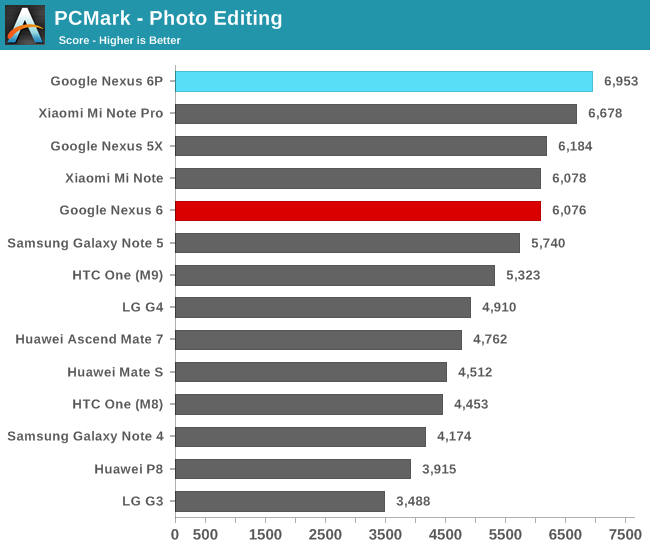
The photo editing uses RenderScript kernels to apply image processing on a set of pictures. With help of a powerful GPU the Nexus 6P performs top of the class
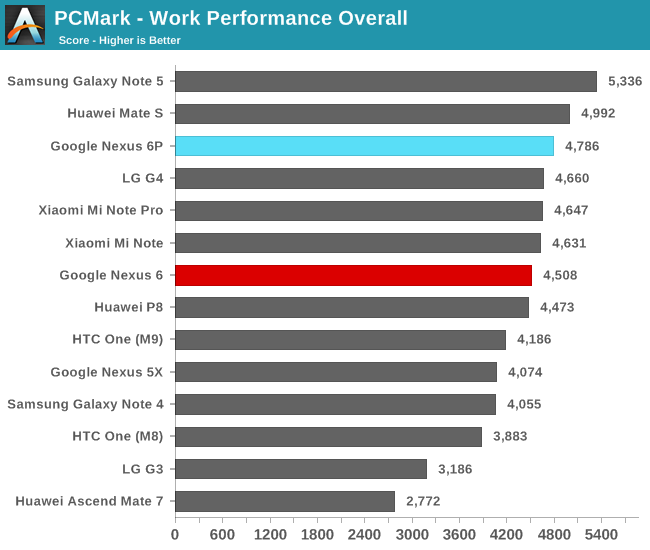
Due to the disappointing writing sub-score the Nexus 6P ends up third in the overall PCMark work performance score. Nevertheless, this is a good showing for the Snapdragon 810 device as it manages to slightly beat the Mi Note Pro and the HTC One M9.










219 Comments
View All Comments
Speedfriend - Thursday, December 17, 2015 - link
"iOS's main "back" action is a simple right-swipe from left edge, which is the best implementation of all."It is crap. It doesn't work in all apps. The one app where I need it most (a trading app when the charting hangs) it simply doesn't work and which is why I have an Android phone as well
star-affinity - Sunday, December 20, 2015 - link
I think that's pretty much the fault of the developer of that app, and mot the functionality of the feature.star-affinity - Sunday, December 20, 2015 - link
Not* (not "mot").theduckofdeath - Monday, December 21, 2015 - link
If it's a poorly implemented system feature it's surely a fault on Apple's side.tipoo - Tuesday, December 22, 2015 - link
It's inconsistent within iOS itself though. Go through a few settings pages and you'll find some support back swipe, some don't.Jason Dick - Thursday, December 17, 2015 - link
This has long been a complaint with Android, but I haven't had any issues with Google Now or Location services on my Nexus 6p. The new "deep sleep" mode with Marshmallow seems to prevent these from causing problems. I ran a little test for myself last week to see if I could go a full 48 hours without recharging the device. I used the phone for some light web browsing and navigation to/from work (total driving time ~1 hour).Using these services really shouldn't be a problem any longer.
eric3448 - Wednesday, June 15, 2016 - link
I just don't know what the problem is.Surely its easy to just download an app if you want something the phone hasn't gotACE76 - Wednesday, December 16, 2015 - link
It's so sad to see Anandtech fall so far from grace since Mr. Shimpi jumped ship for Apple...I still don't understand why Anandtech doesn't at the vbery least point out the architectural differences when comparing smartphones....Android was built to be a true multi-tasking OS...Apple was not...anyone who knows hardware knows single threaded architectures will score higher...honestly, apple's A9 SOCs are nowhere near as powerful as Qualcom's 810 and newer SOCs...maybe if someone could get iOS to run on a Snapdragon SOC, we'd see the truth...kind of like when apple first jumped to Intel CPUs and saw increases of over 600% in performance.tuxRoller - Thursday, December 17, 2015 - link
While I've issues with this review (mostly tone related) I can't say that I've noticed a drop in quality from AT.Also, both ios and Android are "multitasking" but Android gives developers a bit more rope than ios does... sometimes to the detriment of the app.
The A9 is simply the best soc for a phone around. No serious person is questioning this.
Ethos Evoss - Sunday, December 20, 2015 - link
@tuxRoit is best but in draining battery in half day.. they didn't set any power saving modes so their soc ALWAYS runs at max. performance so that is why everybody thinks is best .. but it is all useless,everybody wants lasting long battery life